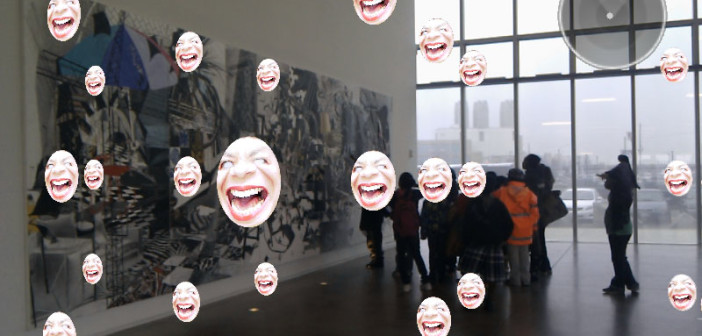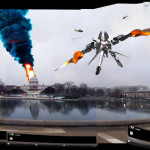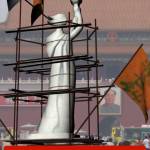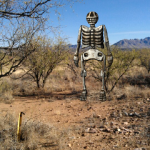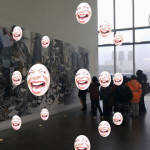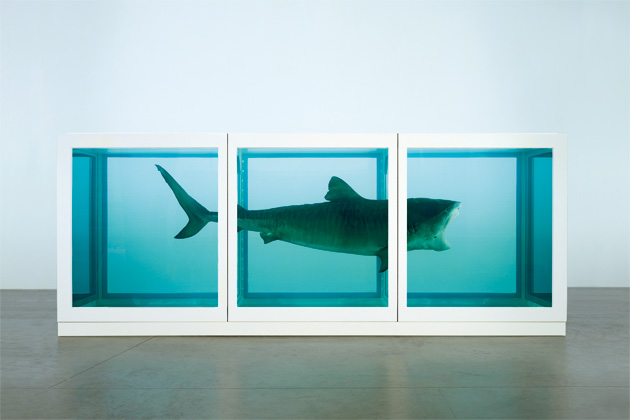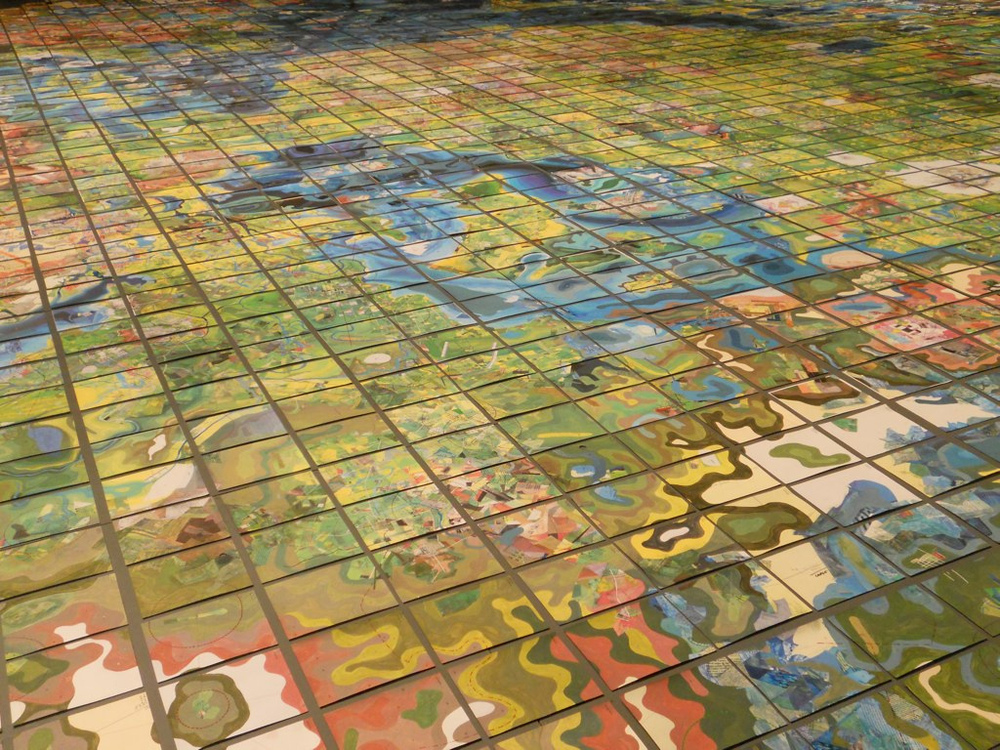There can be no art revolution that is separate from a science revolution, a political revolution, an education revolution, a drug revolution, a sex revolution, or a personal revolution . . .
—Lee Lozano, Statement for Art Worker’s Coalition, 1969.
If you listen to certain voices you will be told that art is irrelevant; that it is not required to succeed in life; that there are better, more profitable things to do. If you are involved in any sociopolitical issue—which means you have a pulse—you know the lie of this alleged wisdom. Making a point requires conjuring images, visual and verbal. Any politician must be an artist; logic alone is not enough. Everyone who stands for something is a politician in this sense. An artist begins where listening to certain voices ends.
Some people might think it a misconception—one which I am about to perpetuate—to regard augmented reality (AR) artworks solely as a mode of sociopolitical protest. To do so, they would say, would diminish AR to a subgenre status, like the mystery novel. The subversive nature of AR, both in assumptions that have become attached to the medium and the ways AR artists have used it, proves this conclusion erroneous. The lure of AR—the ability to place a work anywhere (only the GPS coordinates are required)—makes transgressive acts incredibly alluring. One day there will be AR art as innocuous as a still life of flowers, but not any time soon. The artists who are at the forefront of AR are strongly politically motivated. Associate Professor of New Media at Emerson College, Boston, and AR artist John Craig Freeman: ". . . I would argue that any augmented reality that claims to be art, is necessarily political, even if it appears to be apolitical. The act of evading politics in art is a political gesture and a tacit endorsement of the status quo."1
Augmented Reality—the insertion of virtual elements into an otherwise real environment—is in its infancy, but growing fast. Its potential is enormous, as rather hyperbolically summed up in the AR Art Manifesto of the AR collective manifest. AR: "Augmented Reality (AR) creates Coexistent Spacial [sic]Realities, in which Anything is possible—Anywhere! The AR Future is without boundaries between the Real and the Virtual. In the AR Future we become the Media. Freeing the Virtual from a Stagnant Screen we transform Data into physical, Real-Time Space. The Safety Glass of the Display is shattered and the Physical and Virtual are united in a new In-Between Space. In this Space is where we choose to Create."2
The digital age and "electracy," the successor to literacy, has arrived. A mixed blessing? Of course. Electracy, coined by Gregory Ulmer, Professor of English (University of Florida, Gainesville) and Electronic Languages and Cybermedia (European Graduate School, Saas-Fee, Switzerland), ". . . like literacy and orality before it, is an apparatus, meaning that it is a social machine (part technological, part ideological, part metaphysical)."3 Ulmer proposes an entire new approach to viewing the world, through the internet: "Policy debates until now have been structured by an impasse—the confrontation between the modalities of thought (metaphysics) created within each of the previous apparati: Religion, faith, obedience (Orality) / Science, knowledge, proof (literacy) . . . Electracy proposes the possibility of a third institutional practice, based in an image metaphysics native to digital media, capable of mediating, negotiating, bridging the aporia organizing the relationship between orality and literacy."4 The avatar, or online presence, becomes another state of being, a persona, as a politician has a public persona. Electracy is the structure of that form of communication, a form only just starting to take shape. Ulmer’s theories are well worth study, though his fondness for portmanteau words he calls "puncepts" (electracy, textshop, mystory, post(e)-pedagogy) threatens to collapse into jargon.
Electracy comes most easily to those who have grown up in it; in the term of writer Marc Prensky, "digital natives."5 That generation has only just begun, if it truly is here at all. We "digital immigrants" (Prensky again) must always translate from the text-based world to the digital, greenhorns in a virtual world. But if you have ever been a parent, you know how exciting baby steps can be; if you have ever moved house, you know the excitement of making a home out of a strange place. A world opens up. Change can be invigorating as easily as it is frightening. Not only are we only starting to learn electracy, but the digital world is evolving as well; in effect, we are reading and writing children’s books, where one day we will be in the digital equivalent of Finnegan’s Wake.
The current crop of AR artists are themselves digital immigrants, who came to AR through other art practices. John Craig Freeman: ". . . (B)eginning in 1990 . . . (a)t UCSD I taught courses in all levels of photography and introduced the use of digital technologies into the curriculum . . . 6 Long before augmented reality technology existed, I was experimenting with this concept."7 AR artist and researcher-in-residence at Polytechnic Institute of New York University Mark Skwarek: "Before AR I spent a large amount of time in virtual spaces. I was doing VR (virtual reality) all the time and I play video games on a daily basis. I (was) detached from the physical world—immersed in the virtual. I left my house on a handful of occasions to get food and to fulfill daily obligations—AR completely changed this for me—it opened the physical world to me . . . As I fell in love with the medium I began making lots of work and placing it around the globe. I believe to successfully complete a work requires video documentation. This forced me to leave the house and see the world. Before this my experience of the physical was seen through a virtual lens."8
This change has no direct precedent in living memory, because the previous change—from the oral to written traditions—occurred so long ago. The Bible catches that transformation: from the oral storytelling that shaped the Old Testament, encouraging brevity, utilizing meter, rhyme, and symbolic imagery to encourage memorization, it moves to the letters from the saints, written from and to adepts of the written word. It’s a process that came about gradually, incorporating elements of the older into the newer.
There is continuity in that no transformation is instantaneous; AR builds on many existing art forms. The precedents are many. The appropriation of popular culture, enshrined in art history by the Pop artists and used well before that in political satire, is adopted into the virtual realm. The happy capitalist from the Monopoly game has been assimilated into a symbol of protest (Global Plutocracy, John Craig Freeman); the Goddess of Liberty from the protests at Tiananmen Square appears around the world in digital ectoplasm courtesy of the AR group 4Gentlemen.9 The forms are new, but the language is well-known.
Technology is revolution. The powers-that-be are altered by technology as much as they use technology to their own ends. The conundrum, as posed by philosopher and cultural critic Slavoj Žižek, ". . . how to fight the system without contributing to its enhanced functioning,"10 is broken, at least temporarily, until governments get into the AR game. Like the weather, technology brings change without the reassurance of control. (Conspiracy theorists will tell you we can control the weather; leave them to their delusions.) There is irony, in that acknowledging the presence of a mode of expression legitimizes that expression; for example, China brings greater attention to every form of protest it attempts to censor; a nice Zizekian twist. You can’t arrest an avatar. Freedom of speech also grants the freedom to ignore and, by inference, render unimportant.
AR presents a new facet to protest art, in line with the expansion of protest into the virtual realm. The Arab Spring happened around the world thanks to the internet. For a long time technology was seen as antithetical to protest, which credited hand-made, amateur work with more "genuineness" than anything that looked polished or mass-produced. Technology was a tool of control, and protest was/is about breaking that control. Today a different paradigm is being established. Protests can be facilitated and supported via the internet; what had been assumed to be tools of the establishment were found to be equally usable by rebels. The hand-lettered protest sign carried on a march is still as legitimate a form as ever, but now there are new forms, more insidious and technologically savvy. The computer has been co-opted as a tool of protest, though the hardware and software might come from sources outside of, and/or antithetical to, the protest itself.
We trust what we see; we still do this, despite the near-omnipresence of computer-generated imagery. AR shows us a different space overlaid on our own, part revelation, part accusation. We see in the revealed space a fleeting impression that interaction is more than possible—that we could step into those virtual spaces, and that figures within them can look back at us. The change is a race between culture and consumerism. John Craig Freeman said, "Now, whether or not all of this rises to the level of technological revolution is contingent to some extent on if this transition manifests itself in violent upheaval. Consider for instance the fact that the agricultural revolution and the industrial revolution are considered revolutions instead of evolutions is because of the war and destruction rot by the change. The big lesson of Grammatology, unfortunately, is that the literate invariably colonizes; commits genocide against oral people."
We live in a world that is bombarded by images. When AR comes into common use as an advertising tool, that bombardment could turn into carpet-bombing. ARE2013, the Augmented Reality Event, to be held in Santa Clara, California in June, is being billed as "the largest international event dedicated to Augmented Reality." Its organizers promise seminars on "Leveraging AR to advance your brand," and "How to build successful campaigns and products."11 The artist will have to compete for space as never before. AR promises great opportunity, and the increased danger of sensory overload; at least we can turn off the app and maintain some level of control.
I must throw a sop to art critics, who have an argot that constitutes its own virtual world. AR is "theatrical," in the sense coined by art critic and historian Michael Fried:12 that is, AR art calls attention to the experience of viewing the work, rather than the work itself. To Fried this was a drawback for Minimalism, as it removed focus from the art and shared or replaced this focus with the viewer’s internal experience. This theatricality is inevitable given the nature of AR, and is assumed in protest art, both of which are theatrical in many aspects of the term. To the AR artist, the external is inextricably combined with the art itself, although the art can be placed anywhere at any time.
Art is not revolution, but it can be, not only in our politics, but our understanding of the world. John Craig Freeman: "Most recently, I have been contemplating the way that the transition from literacy to electracy is calling into question our ontology—What is real? and our epistemology—How do we know . . . Virtual and augmented reality gives our epistemological vertigo form. This is why I think that it is so important for artists to be working in this realm. It doesn’t necessarily help us answer the question, ‘what is real?’" But it helps us understand that the question needs to be asked once again, just as it did at the dawn of literacy.
"In oral culture, human thought is ephemeral, it comes and goes. After the advent of alphabetic writing, thought could be recorded and reflected upon, giving rise to the concept of the self. People began to understand that the voices in one’s head are coming from one's head, not from the spirits beyond. Identity formation was internalized, as was subjectivity as we understand it today.
"The technology which gave form to this ontological shift, and which finds its contemporary analogy in virtual and augmented reality, was the camera obscura. Every camera-based image represents both a frame and a point of view, literally and figuratively. Virtual and augmented reality is still an image—representation, but now the image can entered, navigated and explored. The frame has given way to immersion and the point of view has been reassigned from the author to the audience."13
AR imagery is relatively realist; the amount and intent varies from artist to artist. How far could/should they go? A corollary might be found in the field of animated films: for all the attention and accolades given to CG animation, there is a growing opposition. Animation, the critics say, is leaving the field of drawing and entering that of special effects. Motion-capture, which extends the old animation process of rotoscoping (tracing live-action images), turns the artist into a mere technician, robbing animation of its soul. Commercial AR (Ikea has incorporated AR into its 2013 catalog) is determinedly realist. Though there is the inevitable urge to let the technology set the standard, I hope that AR artists will not forget art. At some point the uncanny valley will be crossed (that disturbing moment when verisimilitude is so close to reality, but not quite there) and the object will be replaced by an AR simulacrum.
Philosopher George Dickie’s definition of a work of art is altered (augmented?) or perhaps erased by the AR revolution: "A work of art in the classificatory sense is 1) an artifact 2) upon which some person or persons acting on behalf of a certain social institution (the artworld) has conferred the status of candidate for appreciation."14 This derives from Robert Rauschenberg’s 1961 work, This is a Portrait of Iris Clert if I Say So, and the work of the Minimalists. (In response to Michael Fried I would say that the theatricality he sees in Minimalism is more the result of the spaces in which the art was shown than in the works themselves.) With the slow adoption of so-called street art by the artworld the whole world becomes a gallery in which artists can work. The Institutional Theory of Art, which grew out of Dickie’s theory, becomes redundant: Every space is an Institution; not merely a place that happens to contain art (as in a painting hung in a home) but a place in effect made for art. This is an art gallery if I say so; this is an art gallery whether you know it or not. By that same reasoning you could also argue the opposite: that it is no longer possible to differentiate, erasing the concept of the privileged Institution entirely.
So how can AR endure in opposition to the very same technologies in the service of consumerism? John Craig Freeman:
For the past eight years, I have worked on the corner of Tremont and Boylston Streets overlooking the historic Boston Common, the first public park in the United States. I walk across the park every morning. As I do, I often contemplate the role that the town square plays in shaping of political discourse and national identity formation. As the location of the public sphere, the town square is where we air grievances, display solidarity, express our difference, celebrate our similarities, remember, and mourn. Imagine the entire mobile Internet, and its physical manifestations’ of place, as a world wide public square.
This threat/promise is a context for experiments in virtual and augmented reality, which allows us to overlay this virtual public sphere onto our experience of the physical, cultural world. It is important to keep in mind that the practices of the virtual public sphere have to be invented, just as the equipment is invented. What is the future of ‘We’ in electracy? It is open to invention.15
AR is part of the tide of change that is sweeping across the world, bringing people together in a virtual, boundary-free environment, creating or enhancing new social mores, bringing the future imagined in science fiction into reality. That, at least, is one scenario. Whether AR artists can prevail against the very consumerism that their works protest, even as the markets embrace AR itself, is another matter. At this time, there is no way to tell. There will always be protests, room for improvement, and AR is a valuable tool to the politicized artist. Mark Skwarek: "After a few projects I became somewhat addicted to the act of creating and placing artwork around the earth. The challenge of creating a work and documenting it in the real world changed the way I live. I see this as one of the greatest powers of AR: the ability to mobilize the general public, to get people out from behind their TVs and computers and to experience the real world. The obesity rate in the US has skyrocketed over the last twenty years. I have been working in a field (video games), which could be seen as partially responsible for the epidemic. My art practice has always been about trying to make the world a better place (not all of it—but some). I foresee many people (corporations, nation-states) misusing this technology. I see myself and the work I make as a balance . . . I really love site-specific GPS-based AR work. I have traveled the globe creating works from North Korea to Disneyland. Site-specific work is not new to media art but this type of networked experience that requires the viewer to travel to the location for the experience is new for most of the public."16
From here on I leave speculation up to soothsayers reading the entrails of chickens; virtual chickens, please. Artists have made AR protest art the cutting edge of their field, but every cutting edge goes dull in the end and must be renewed. In many ways—and this is what drives protests—the future seems out of control. But we’re here at the beginning, whence curators will turn for their retrospectives, where the world was (re)made or all went wrong—take your pick. The remains, hopes or dreams, or what-have-you, can even be resurrected via AR, in a collaboration between John Craig Freeman, AR artist Scott Kildall, and manifest.AR: "‘EEG AR: Things We Have Lost,’ will allow participants to conjure up virtual objects by simply imagining them into existence using brainwave sensor technology. We will generate a database of objects based on the broad theme of "Things We Have Lost," which includes things such as pensions, empires, and dodo birds. We will outfit test subjects with EEG-reading brainwave sensors and ask them to think deeply about what he or she has lost. Once our software detects a measurable and consistent pattern, it will issue a database call to instantiate a virtual object using augmented reality technology. The virtual object will then appear in front of the participant, viewable on any iPhone or Android device. As part of the exhibition, we will take the test subjects into the city to see if it is possible to create and place virtual objects just by thinking them into existence. These virtual objects will remain at the location as trace reminders of the lab experience."17 Nostalgia, tristesse, meet the future.
- Composite image of Giant Robots are attacking the Capital! posted on January 13, 2013 on Mark Skwarek’s blog.
- 4 Gentlemen’s Chinese Statue of Democracy, installed in Tiananmen Square.
- John Craig Freeman’s Border Memorial, near Benson AZ.
- Art Critic Face Matrix Reloaded, Installed at the ICA Boston by Tamiko Thiel
[1] John Craig Freeman, email to the author, November 23, 2012.
[2] http://www.manifestar.info/
[3] Gergory Ulmer, http://heuretics.wordpress.com/electracy/
[4] Ulmer, http://heuretics.wordpress.com/about-2/
[5] Prensky first used the term in On the Horizon (MCB University Press, Vol. 9 No. 5, October 2001)
[6] http://johncraigfreeman.wordpress.com/john-craig-freeman-dossier-2012/candidate-statement/#professional_work.
[7] Freeman, November 23, 2012
[8] Mark Skwarek, email to the author, November 30, 2012.
[9] http://fourgentlemen.blogspot.com/2011/02/egypt-china.html
[10] Žižek, Slavoj, The Year of Dreaming Dangerously, Verso Books, 2011, Introduction.
[11] http://augmentedrealityevent.com/
[12] Fried, Michael, Art and Objecthood: Essays and Reviews, University of Chicago Press, 1998.
[13] Freeman, November 23, 2012
[14] Dickie, George, Aesthetics: an Introduction, Pegasus Books, 1971.
[15] Freeman, November 23, 2012.
[16] Skwarek, November 30, 2012.
[17] http://johncraigfreeman.wordpress.com/eeg-ar-things-we-have-lost/
Top Image: Art Critic Face Matrix Reloaded at the ICA Boston, by Manifest.AR member Tamiko Thiel.

